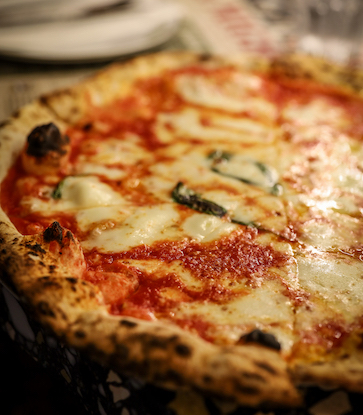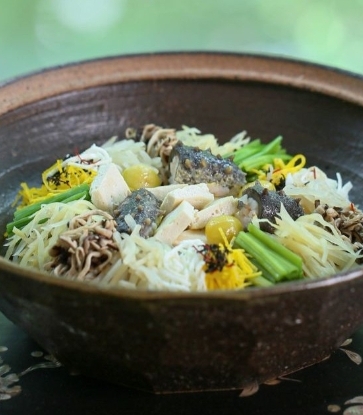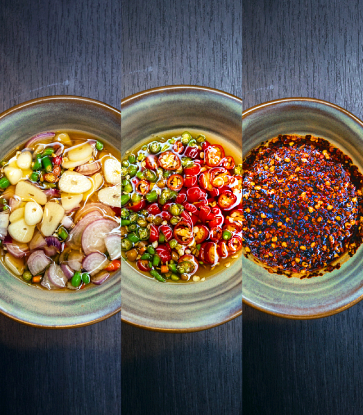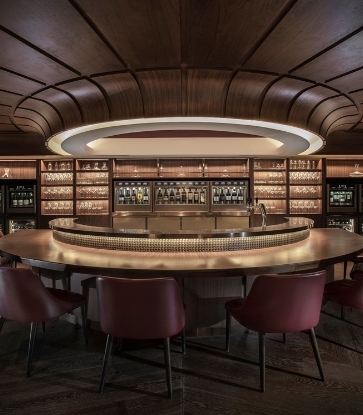From layers of umami to charred wok’s breath, the elements of flavor in Chinese cuisine are complex, making wine pairing a challenge. However, if done well, the magic that wine and food can weave together can still be conjured, and each can add to the experience of the other.
Here, we meet Thomas Ho, consultant sommelier of One MICHELIN Star and Green Star recipient Mountain And Sea House, Xavier Tzeng, chief sommelier of one-MICHELIN-starred La Maison de Win in Taichung, and Jerry Chao, chief sommelier of MICHELIN-listed 85TD. Three sommeliers of Chinese restaurants with extensive wine collections who use their expertise to design wine pairing selections with Chinese dishes...a rarity in Chinese restaurants. We invite them to elaborate on their selection processes and methods, based on two classic Lunar New Year dishes: Buddha Jumps Over the Wall and White Poached Chicken, as well as one of their restaurant's signature dishes.

The Principles of Pairing Chinese Food with Wine
At Mountain And Sea House, Ho’s guiding wine pairing principle is simply to “avoid making a good wine taste bad”. In most Western cuisines, dishes are served course by course, each with an individual pairing. The difficulty with Chinese cuisine is that most of the time, all the dishes are served simultaneously and there may be two or more dishes on a guest's plate at any one time. "Since there are so many flavors going on, I think the most important thing is to grasp the general direction, and then eliminate any landmine combinations," Ho says.
Such principles of pairing are summarized in his book Food & Wine Pairing: A Sommelier's Guide to Food Pairing. In it, he highlights wines with low tannins, high acidity, slight sweetness, low alcohol, less oak barrel-aging, and those that can be served colder — these, he says, are safer options for pairing with food.
For Tzeng of La Maison de Win, the first task when pairing Chinese food with wine is dealing with sweetness and umami in the dishes. He believes that while these two flavor profiles are the most delicious elements of Chinese food, they also make it challenging to pair with wine. Sweetness in food may bring out bitter and sour notes in wine, while umami drags out a mineral finish in the throat. Patience is required to experiment and find the most suitable combination.
He shares the three main levels of food and wine pairing: first, eliminate the conflict between tannins and sweetness and umami; second, match the weight and texture of the wine and the food; and finally, pair the aroma of the food and wine.
85TD’s Chao believes that Chinese food is not only rich in umami, but also smokiness from wok’s breath. Therefore, he chooses wine with high acidity to bring out the sweetness of the dish and cut through the rich flavors with a mineral-tasting element.
As a sommelier, he reckons that he plays the role of an assistant to the chef, prioritizing the meal first, and wine second, playing with flexibility in adjusting the wine pairings to best suit the dishes so their flavor remains unchanged.
RELATED: The Perfect Pair: How to Select Holiday Season Bottles
Buddha Jumps Over the Wall
Although Buddha Jumps Over the Wall is a staple on Taiwanese New Year's Eve tables, it is one of the most discussed dishes among sommeliers and considered the most difficult to pair with wine.
First of all, it is not common in Western cuisine to pair soups with wine. Chao explains that this is because when soup is served hot, it amplifies the burning alcohol sensation that the wine has in the mouth, making it unpleasant. In addition, the rich meats in the dish such as chicken, pork, and seafood — as well as strong sweet and umami seasonings like rock sugar, Shaoxing wine, ginger slices, light soy sauce, and stock, make it a challenge to pair with wine.

The first wine Ho recommends is a Mountain And Sea House exclusive, made by local winery Weightstone. The Shanshi Micro-sparkling Wine La Roche d’Or is made using the traditional champagne brewing method, but with a culinary twist in the final sugar-adding stage. Brown sugar syrup, a secret ingredient of old Taiwanese chefs used to substitute MSG and enhance umami in dishes, is added to the wine, making it fuller and rounder, with an aroma of burnt sugar. Pairing local food with local wine adds another unique dimension. He also recommends prosecco, an Italian sparkling wine whose slightly sweet notes echo the sweetness of the Buddha Jumps Over the Wall. The light body of the prosecco and effervescent bubbles cut through the rich and sticky mouthfeel of the braised dish, making it a perfect match.
After years of experimentation, Tzeng agrees that prosecco is the most suitable wine to pair with Buddha Jumps Over the Wall, even over champagne, which is usually favored. He explains that like champagne, the sharp carbonation of prosecco washes away the sticky feeling in your mouth after consuming the dish. But if paired with champagne, the rich umami of the braised dish tends to destroy the delicate taste structure of champagne and bring out its sour notes.
"But prosecco doesn't have this problem. When its sweetness meets the sweetness of Chinese food, it brings out a floral aroma instead." Tzeng adds that prosecco is often served first as a welcome drink, while Buddha Jumps Over the Wall usually appears early in the meal as well, making them a timely match.

At 85TD, Chao explains that unlike the Taiwanese version of Buddha Jumps Over the Wall, the restaurant's Cantonese version does not include taro to increase the viscosity and weight of the sauce, so he would choose an equally light-bodied wine to pair with it. Secondly, since 85TD’s Buddha Jumps Over the Wall is a heavy dish rich in umami, he would pair it with a wine that has a slightly sweet finish or a fruity aroma, like Fukuda Sake Brewing Company’s Nagasaki Bijin Daiginjo.
Chao previously experimented with pairing the dish with Junmai Daiginjo, but it was too sweet and overpowered the taste of the dish. When pairing with Bijin Daiginjo, Chao recommends chilling the sake to about 5°C, as the residual heat in the mouth from eating the dish will bring the temperature of the sake back up and amplify its flavors and aromas.
Next, he recommends the Greywacke Wild Sauvignon Blanc from Marlborough, New Zealand, chilled to about 8°C, after taking into account the temperature difference between wine and soup. When drinking the soup, the high temperature in the mouth will bring up the temperature of the wine and release its aroma molecules. The ideal temperature for tasting the wine is when it is raised to about 15°C to best bring out its outstanding aromas of ripe pineapple, passion fruit, and dried apricots, as well as its long and beautiful finish.

White Poached Chicken
Another dish commonly found on the Lunar New Year’s table is White Poached Chicken, a simple looking dish that is all about capturing the natural flavor of chicken. To pair, Ho chooses an umami-packed wine like Fenrir Kura’s Junmai Sake Yoshino 1 Single Pasteurization, a sake made from Yoshino 1 rice, grown locally in Shoufeng, Hualien. The sake pairs well with the chicken, cutting through its greasiness with slight pungency. Ho recommends pairing this sake with other similarly umami dishes like raw meat, fish, and abalone.
Ho also recommends pairing the dish with Tio Pepe Fino Sherry, which can be easily bought on the market. He explains that this sherry is not sweet and carries a salty note because it is produced near the coast, pairing well with the savory chicken when drunk ice-cold.
While Tzeng believes that chicken dishes are very suited for pairing with light-bodied reds, White Poached Chicken is served with a garlic soy sauce that contains sugar, the natural enemy of wine pairing. Therefore, he recommends Yvon Métras, a well-known winery from France’s Beaujolais region.
"The reason why sugar is the biggest enemy of wine is that sweetness will cause the tannins in wine to express itself as a sour and metallic taste. Beaujolais may be the most suitable red wine to pair with seafood because it is made by carbonic acid maceration (Macération Carbonique), a special fermentation technique that reduces the tannin content, resulting in a light and fresh style with rich fruit aroma," Tzeng explains.

85TD’s version of poached chicken is its Chicken with Conpoy Broth, which includes broth, shredded scallops, Jinhua ham, and other umami elements that are not normally found in the dish. It is served not with the usual garlic soy sauce, but with a ginger paste made from a blend of ginger, chicken fat and salt.
For this dish, Chao recommends the 2021 Martin & Anna Arndorfer Herrengasse 4, a white wine with a unique citrusy acidity that lengthens the heat of the young ginger without amplifying its spiciness and cuts through the richness of the chicken fat.

Other Examples of Chinese New Year Food and Wine Pairings
In addition to these two classic Chinese New Year dishes, we also invited the three sommeliers to share their tips for pairing Chinese food and wine using their respective restaurant’s signature dishes as examples:
Mountain and Sea House: Fish Along the Willows
This classic Taiwanese dish combines wild white pomfret from Penghu with three sources of acidity: a fruity vinegar, a vegetable-based tang, and brightness from sun-dried daylily, which bring distinct layers of sweet and sour flavors that blend together seamlessly. Ho recommends pairing such sweet and sour dishes with wines that are reminiscent of salted lemonade, carrying sweet and sour notes with aromas of candied fruit and florals.
First up is a special Vino Formosa Rosso from Domaine Shu Sheng in Taichung that carries aromas of honey, candied fruit, and tropical fruit, as well as a balanced sweet-sour profile with a refreshing finish. Next, Ho suggests pairing the dish with a German Riesling Kabinett, a slightly sweet white wine with bright and lively acidity.

La Maison de Win: South African Abalone with Shrimp Roe
La Maison de Win’s signature dish features a rich marinade of old hen’s broth, as well as a special sauce made from rich, savoury ingredients like pig’s feet, scallop juice, and dark soy sauce. Because strong umami flavors like this tend to stand in conflict with most wines, Tzeng recommends pairing it with wines made from aromatic grapes such as Gewurztraminer, Muscat, Viognier, and Riesling, with strong floral and fruity aromas that stand up to umami flavors.
The first wine he recommends is the 2020 J. Denuziere from Condrieu in France. Made from Viognier grapes, the wine boasts an elegant honey-flower aroma with low acidity. The next is the 2022 Elena Walch Gewurztraminer Alto Adige from Italy. Tzeng believes that Gewurztraminer is the most fragrant variety among aromatic grapes, and this Gewurztraminer in particular has low sweetness and a rich floral and fruity aroma with a unique ginger-like nose. Besides this dish of abalone and shrimp roe, the wine can also pair well with other dishes with strong Asian spices.

85TD: Peking Duck Style Roasted Goose
This dish is made by marinating male geese from Changhua, Taiwan, in a spiced seasoning, and then applying a coat made of maltose, red vinegar, and wine before it is hung to dry for a day. The bird is then blow-dried before grilling. In addition to enjoying the sliced skin and chopped meat Peking duck-style, one of Chao’s favorite ways to eat the meat is in a dish of stir-fried diced goose.
He recommends pairing the poultry with a Pinot Noir like Thibault Liger-Belair Burgundy “Les Grands Chaillots”, a medium-bodied wine with pleasant fruity aromas of red berry, cherry, and red plum. The pleasant acidity of the red wine also works to cut through the greasiness of the goose fat, with just the right amount of tannins to support the rich flavors of the accompanying sauce. The wine also pairs well with the second cut of goose meat, its fruity aromas complementing the accompanying plum sauce made with vinegar, perilla plum and sugar.
This article has been translated by Rachel Tan from its original Chinese version.
Hero Image: Buddha Jumps Over the Wall from Mountain and Sea House and co-branded La Roche d'Or. Photo courtesy of Mountain and Sea House.




















